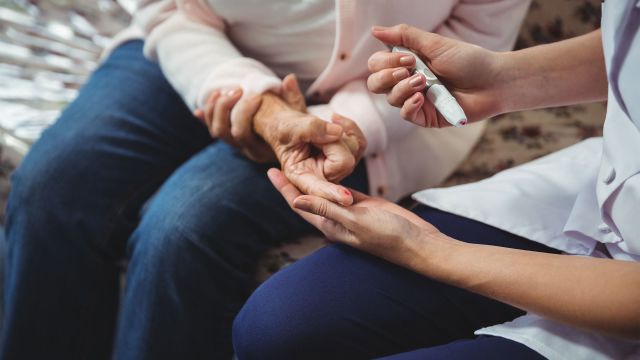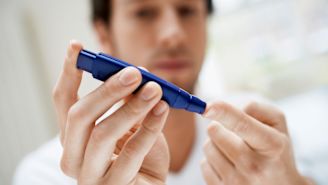Updated on March 22, 2024.
If you have diabetes, you may have heard of diabetic ketoacidosis (DKA) and hyperosmolar hyperglycemic nonketotic syndrome (HHNS), also known as hyperosmolar hyperglycemic state (HHS). These are two of the most common life-threatening emergencies that may develop in people with diabetes. The complications can happen when diabetes is not controlled well enough, causing blood sugar levels to rise to dangerous levels.
Prevention is the best strategy against these complications. This includes checking your blood sugar levels as often as your health care team recommends and taking your diabetes medicine as prescribed.
But even when following treatment recommendations, blood sugar levels can fluctuate. Sudden illness, unexpected surgery, pregnancy, changes in your everyday routine —all of these things may lead to unexpected increases in blood sugar levels. And that can increase your risk for diabetic ketoacidosis and HHNS. The earlier these conditions are identified and treated, the better. Left untreated, these conditions can lead to brain swelling, diabetic coma (unconscious and unable to wake up or respond to putside stimulation), and even death.
While they can be serious, diabetic ketoacidosis and HHNS are treatable. To prevent them, it’s crucial to learn the symptoms of these complications so you can notify your healthcare provider (HCP) and seek care. Although symptoms may take days or weeks to develop in some cases, they can often worsen quickly, requiring immediate medical attention.
What is diabetic ketoacidosis?
The body’s normal source of energy is sugar (glucose). Insulin is a hormone that helps move glucose from the bloodstream into the body’s cells where it can be used for energy. If you don’t have enough insulin —for example, if you missed your daily insulin injection— glucose stays in your blood, causing blood sugar levels to rise. The cells of your body are unable to get the glucose they need, and instead begin to burn fat for energy.
The breakdown of fat produces acidic chemicals called ketones. When ketones are produced too fast and build up in the urine and blood, they can poison the body by making the blood acidic. While this buildup may occur slowly, DKA can develop within a few hours, especially if you are sick and vomiting.
Early signs of diabetic ketoacidosis
When ketones first start to build up, you may notice you:
- Are dehydrated
- Are urinating often
- Have high blood glucose levels
- Have high levels of ketones in your blood and urine (see section below on how to check for ketones)
If you do not notice these initial symptoms and ketones continue to accumulate, you may start to experience vomiting, nausea, or abdominal pain. Your skin may also feel dry or flushed (red or warm feeling skin), and you may notice your breath smells fruity or foul. The condition may also cause problems with thinking, such as confusion or difficulty paying attention.
Checking for ketones at home
You can check your ketone levels with over-the-counter blood and/or urine testing kits. Ask your HCP about how to keep track of your levels, when and how often you should test, and when you should call for help.
Most experts recommend checking for ketones if you:
- Are ill, such as with a cold or flu
- Have a blood sugar level higher than 240 mg/dl
- Have any symptoms of diabetic ketoacidosis (as mentioned above)
Potential causes of DKA may include:
- Missing a dose of insulin
- An injury or recent surgery
- A severe infection or illness such as pneumonia (lung infection), urinary tract infection, or other infection
- A traumatic event (emotional or physical)
- Taking a new medicine that may affect your blood sugar levels
If your ketone levels are high, you’re vomiting, or your blood sugar level is high and not decreasing with treatment, call 911 immediately.
Risk factors for diabetic ketoacidosis
While anyone with diabetes can get diabetic ketoacidosis, it’s usually seen in those with type 1 diabetes, including those with type 1 who have not yet been diagnosed. Type 1 diabetes develops when your body can no longer produce the hormone insulin, and requires insulin medication to survive.
Although it's less common, diabetic ketoacidosis can also develop in people with type 2 diabetes (when the cells of your body develop insulin resistance and can no longer respond well enough to insulin). A sudden infection, such as pneumonia, can make your insulin levels decrease to very low levels, and cause ketoacidosis.
When you’re ill—whether you have type 1 or type 2 diabetes—make sure you are extra careful about checking your blood sugar levels.
How HHNS is different from diabetic ketoacidosis
When HHNS develops, your body is producing enough insulin and does not need to burn fat for energy, but your body is not producing enough insulin to prevent high blood sugar levels. With HHNS, blood sugar levels can be very high but ketone levels are normal or only slightly elevated, which is different from diabetic ketoacidosis when ketone levels are increased.
Initially with HHNS, your body tries to unload the extra sugar through your urine. If you feel an increased need to urinate, it’s a good idea to check your blood sugar levels.
Other signs of HHNS may include:
- A blood sugar level higher than 600 mg/dl
- A high fever
- Dry mouth or extreme thirst
- Warm skin that doesn’t sweat
- Vision loss
- Leg cramps
- Weight loss
- Difficulty moving
- Hallucinations (seeing or hearing things that are not there), seizures, or difficulty speaking
- Coma (unconscious, and unable to be woken up or respond to outside stimulation)
When you notice signs of HHNS, it’s critical to drink liquids to prevent dehydration. Without enough fluids, your blood can become too concentrated in sodium and glucose, a condition known as hyperosmolarity. When this occurs, your body will start drawing water out of your organs, including your brain.
HHNS may develop more slowly than DKA but HHNS is also a medical emergency. If you have any symptoms, go to the emergency room or call 911.
Risk factors for HHNS
Like diabetic ketoacidosis, infection—mainly pneumonia and urinary tract infection—is a major cause of HHNS, responsible for 30 to 60 percent of all cases.
Other factors that can increase your risk for HHNS include:
- Stressful events, such as heart attack or stroke
- Conditions or medicines that increase fluid loss
- Poor kidney function
- Stopping or running out of insulin or other medicines that lower glucose level
- Reduced thirst
- Having uncontrolled type 2 diabetes
HHNS is commonly seen in people ages 55 and up, as older people may have a higher risk of becoming dehydrated and having impaired kidney function. Dehydration can cause confusion and weakness, making it harder to recognize thirst and other signs of HHNS.
How to prevent HHNS
HHNS only develops when your blood sugar levels are not controlled. Here are some ways to help you prevent it:
- Check your blood sugar regularly. How often you should check depends on the type of diabetes you have and your current treatment plan. For example, a person with type 1 diabetes may be advised to check their blood sugar 10 times a day. Talk with your HCP about what your target blood sugar ranges should be.
- Take extra care of yourself when you’re sick—especially if you’re older. Drinking a glass of water every hour and checking your blood sugar more often than you normally would are both good ideas. Ask your HCP to help you create a sick-day plan specific to your needs.







